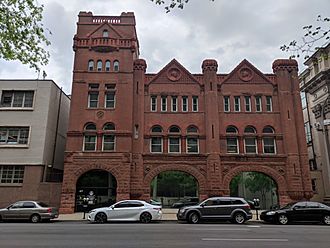Louisville Sinking Fund Building facts for kids
Quick facts for kids Sinking Fund Building |
|
|---|---|
 |
|
| Alternative names | Fire Station No. 2 Louisville Metro Office Building |
| General information | |
| Address | 617 W. Jefferson St. |
| Town or city | Louisville, Kentucky |
| Country | United States |
| Completed | 1891 |
| Renovated | 1937 |
| Height | |
| Architectural | Romanesque |
| Technical details | |
| Material | Red sandstone and bricks |
| Floor count | 5 |
| Design and construction | |
| Architect | McDonald Brothers |
| Designations | National Register of Historic Places, 1976 |
The Sinking Fund Building, also known as Firehouse No. 2, is a historic building in downtown Louisville, Kentucky. It's located on Jefferson Street, near the Louisville Metro Police Headquarters and the Louisville City Hall Annex. This building is part of a group of city offices.
Today, it holds the office of the Louisville Metro Revenue Commission. This group handles taxes for the city and county government. The building was added to the National Register of Historic Places in 1976, which means it's recognized as an important historical site.
A Look Back: History of the Building
When It Was a Fire Station
The Sinking Fund Building was designed by the McDonald Brothers, an architecture firm from Louisville. It was built in 1891 to be the headquarters for the city's fire department. The building got its name because it was paid for using a special fund called a "sinking fund." This fund was set aside over time for a specific purpose.
The building was made from red sandstone and bricks. Its style is called Richardsonian Romanesque, which is a type of architecture that looks strong and grand.
Originally, the building had a tall, five-story tower. This tower was used to dry fire hoses and also served as a lookout. Firefighters could climb up to spot fires in the surrounding area. Later, the very top part of this tower, called the belfry, was removed.
The front of the building has cool sculptures of two important people. One is Benjamin Bache, who was the fire chief at the time. The other is Emile Bourlier, who managed the sinking fund. At the bottom of the building, there are three big arches. These were once doorways for the horse-drawn fire engines. The second floor was used as offices and sleeping areas for the firefighters.
In 1937, the fire department moved to a new location. After they left, the police traffic department moved into the building. Money had been saved to fix up the building for the police, but these funds were used instead to help rebuild after a big flood from the Ohio River that year. Later, in 1943, the police patrol division also moved in.
Becoming the Sinking Fund Building
By the mid-1950s, the police department had moved out. In 1957, the building was officially named the "Sinking Fund Building." About $97,000 was spent to renovate it. This gave the Commissioners of the Sinking Fund more space on the first floor. The upper floors, used by the Welfare Department, also got air conditioning.
The Commissioners of the Sinking Fund was an old agency. It was created in 1852 to manage city finances. This group was the early version of what is now the Louisville Metro Revenue Commission. The building has often been home to the city's tax collectors. In the mid-1960s, it was even used to hold equipment for a study about air pollution downtown.
In 1969, a city consultant suggested tearing down the building. The idea was to build a new, modern government complex. This plan, costing $23.4 million, was put to voters in 1970 but was voted down.
Less than six years later, in September 1976, the Sinking Fund Building and the city hall complex were placed on the National Register of Historic Places. This protected them as important historical sites. In 1975, the Louisville Department of Building and Housing Inspection moved into the Sinking Fund Building. The building was updated for them, including adding an elevator. The renovation work continued into the late 1970s. During this time, the names of Bache and Bourlier were uncovered on the front entrance.
In 1992, the Sinking Fund agency moved out of the building because they needed more space. They moved to West Main Street, where they could keep all their records in one place. However, the Revenue Commission later moved back into the building. Another city department, the permit agency, also moved out in 2004.

